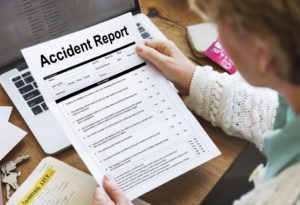How To Read Your Texas Car Accident Report

If you have been hurt in a car accident in Texas, you may not be familiar with the steps you need to take to secure compensation for your injuries and damage to your property. One of the most important pieces of information that can help your injury claim is your accident report. If you need to pursue legal action against the person who caused the crash, reading and understanding your Texas accident report is often vital to your case.
The Texas Department of Transportation (TxDOT) is the agency that stores and issues crash records for the state of Texas. A Texas Peace Officer’s Crash Report (CR-3) is completed by a law enforcement officer investigating a traffic crash involving damage of $1,000 or more or a collision resulting in injury or death. A Driver’s Crash Report (CR-2) is completed by a driver involved in a crash not investigated by a law enforcement officer, with damage less than $1,000, or that did not result in injury or death.
The general public can’t view crash reports online, but involved parties can obtain a copy of a CR-3 through the TxDOT website. Any person involved in a motor vehicle accident in Texas should obtain a crash report to ensure that information was recorded correctly.
A standard crash report is generally two pages long, but not all sections may be filled out. In general, the information that can be found on each page is as follows:
How To Read Your Texas Accident Report
The first page of a Texas crash report typically contains information about the drivers, their vehicles, and the location of the accident. The Identification and Location section includes:
- Date and time of the crash
- County, city, and longitude and latitude information
- Checkboxes indicating if the officer believed the crash resulted in at least $1,000 of damage
- The road on which the crash occurred, with boxes that may be checked for accidents occurring on private property, toll roads or lanes, construction zones, or workers being present
- The speed limit for the listed road
- Section for nearest intersecting road information when a crash occurs somewhere other than an intersection
The next section on the first page is dedicated to Vehicle, Driver, & Persons. In this section, you will find two sections (one for each vehicle) for such information as:
- Vehicle year, color, make, model, and body style
- Checkboxes denoting if the vehicle was parked or accident was hit and run
- Vehicle identification number (VIN)
- Driver’s license information
- A section for people involved that includes an assigned person number, person type (driver, passenger, pedestrian, etc.), seat position, full name, injury severity, age, ethnicity, sex, and restraint, helmet, and airbag information
- Box to denote whether the person is vehicle owner or lessee
- Proof of financial responsibility
- Towing information
Page Two
The second page begins with the Disposition of Injured/Killed. This section contains a unit number, person number, where they were taken to, who they were taken by, and date and time of death.
The next section is for Charges and lists a unit number, person number, the charge, and the citation or reference number. Below that is a section for Damage in which you will find types of damages property other than vehicles as well as the names and addresses of those owners.
The next section is for commercial motor vehicles (CMVs) and includes:
- Checkbox if CMV is 10,001+ pounds
- Checkbox denoting CMV was carrying hazardous materials
- Checkbox for 9+ capacity
- Checkboxes to indicate CMV disabling damage
- Vehicle operator
- Carrier type
- Carrier ID number
- Carrier’s corporate name
- Carrier’s primary address
- Vehicle type
- Bus type
- Checkboxes denoting RGVW or GVWR with slots to enter weight
- Checkboxes to denote if the vehicle was HazMat released
- HazMat ID number and class number
- Cargo body style
- Four boxes for the sequence of events
The next section is dedicated to Factors and Conditions. In this section, you will find one section devoted to contributing factors in the investigator’s opinion, vehicle defects in the investigator’s opinion, and environmental and roadway conditions.
In the Narrative and Diagram section, you will find an officer’s written narrative of the crash and possibly diagrams in the box to the right. Below this is information about the investigator, including the time they were notified, how they are notified, the time and date they arrived, and the investigator’s name, agency, and ID number.
What to Know About Texas Crash Reports
A crash report can easily be more than two pages when a wreck involves more than two vehicles. Since these reports are handwritten, many people can have difficulty reading the recorded information.
It costs $6 to obtain a regular copy of a CR-3 from TxDOT, or $8 for a certified copy (for a legal proceeding).
TxDOT collects crash reports from every law enforcement agency in Texas and the state retention schedule for crash reports and data is 10 years plus the current year. While the schedule effective in 2015 contains only five previous years plus the current year, TxDOT will continue to add one year to the retention schedule every year until the 10-year retention schedule is met.
Under Texas Transportation Code § 550.065, any person who has a connection to the accident can get a crash report upon written request. The report will be released once the required fee is paid. Parties who are eligible to obtain a crash report include:
- Persons involved in the crash
- A driver who was involved in the crash
- The parents, legal guardian, or employer of a person in the accident
- Vehicle or property owners involved in the crash
- Any person who is financially responsible for a vehicle involved in the crash
- The insurance company that issued a policy covering a vehicle in the crash
- Insurance companies that have policies covering any person in the accident
- Federal Communications Commission (FCC) licensed radio stations or TV stations
- Any free, general circulation newspapers or Texas Government Code § 2051.044 qualified publications that are allowed to publish legal notices
- Persons who have a right to bring a wrongful death claim due to the accident
- Federal, state, or local government agencies
How a Crash Report Can Impact Your Claim
After a collision that causes severe injuries or significant property damage, the individuals involved in the crash should take all the necessary precautions to protect themselves. This includes contacting the authorities, getting witness statements, obtaining the insurance information from the other party, and obtaining a copy of the crash report once it has been filed.
Getting a copy of your crash report in Texas is a relatively simple process and is a vital step toward getting the full and fair compensation you are owed after an accident. You should not have to pay out of pocket for the expenses associated with a collision that was not your fault and having an accident report that proves the other party was at fault can help strengthen your case with the insurance companies.
If you have to pursue a personal injury claim, this report could prove to be invaluable to your case. Your attorney will want to review the accident report as part of their investigation and will use it (along with other evidence) to build a strong, convincing case on your behalf.
What If I Find Inaccuracies in My Report?
Once you have obtained a copy of your accident report, it is vital that you review it for accuracy. A mistake in a crash report could severely harm your case and could give the insurance adjuster reason to deny your claim. So, what can you do if the report leaves out essential information, contains errors, or draws the wrong conclusion?
Unfortunately, it can very difficult to get a crash report amended. You might wish to speak with the police officer as soon as possible after the crash and make sure they know all of the facts about how the accident happened. You could also consider offering a written statement that outlines the sequence of events as you experienced them. You can include photos of the scene, your vehicle, injuries you suffered, and any other evidence that might support your claim. If the officer does not want to amend the report, you could request that your statement is included as an attachment.
Before speaking with the authorities or submitting any written statements, it is a good idea to hire an attorney to represent you. Your lawyer can advise you on the best way to communicate with the officer and will make sure that any statements given are free of any errors or omissions that might harm your claim.
Contact a Houston Car Accident Attorney for Help
If you need help obtaining or reading your crash report, or you think there might be factual errors in your accident report, you should immediately contact Fleming Law. Our firm assists motor vehicle crash victims in communities all over the greater Houston area.
Call us or contact us online today to take advantage of a free consultation that will let our Houston car crash attorney provide a complete evaluation of your case.

Brendan received his JD from South Texas College of Law and his MBA from Baylor University. He then began his legal career as in-house counsel for a publicly-traded company, advising on matters such as mergers and acquisitions, securities, compliance, and general corporate transactions. He then worked at a national law firm in which he represented commercial banks, private equity firms, and business owners in complex transactions before joining Fleming Law, Brendan uses his considerable knowledge of business-related matters by working on cases involving business law, real estate law, and contracts. Connect with me on LinkedIn








